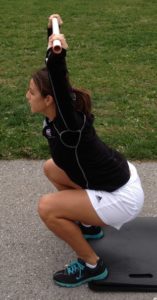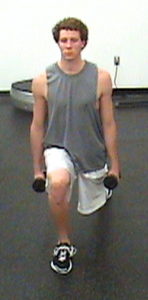Ankle Dorsiflexion:
As we have discussed, there is a ripple effect up the entire kinetic chain. A dorsiflexion restriction is very evident in squatting and lunging patterns. Keep in mind that the very same squatting and lunging patterns are some of the most fundamental movements in all of sport. So, ignoring these issues and problems is simply asking for long term performance issues and high injury rates.
Poor dorsiflexion will affect lunges and squats in several ways. As we have said, it will limit the athlete’s ability to effectively squat deeply and move cleanly, so an athlete will find another way to get the job done. Remember that the body will aways find the path of least resistance. Meaning, the body will always sacrifice quality of motion for quantity of motion. So, if you ask an athlete to squat lower (quantity of motion), it will find the easiest path to get lower, even if it is a poor quality squat (or lunge).
The Squat is likely the most fundamental movement pattern for all athletics, and  for life in general. If we can’t squat in functional manner, we will struggle to sit in a chair, much less stand in an athletic ready stance.
for life in general. If we can’t squat in functional manner, we will struggle to sit in a chair, much less stand in an athletic ready stance.
Poor Ankle Dorsiflexion has huge impact on an athlete’s ability to squat. Poor dorsiflexion will limit an athlete’s ability to get in a good, deep squat.
To learn more about how ankle dorsiflexion affects squats, click here…
 The lunge is a close second to the squat for functionality in an athlete. In the case of a lunge, we are asking the body to perform many of the same movements as they do with a squat, but now in a single leg stance position.
The lunge is a close second to the squat for functionality in an athlete. In the case of a lunge, we are asking the body to perform many of the same movements as they do with a squat, but now in a single leg stance position.
This position makes the body much less stable and puts a huge load on one leg. Thus, the demands on the glutes, hamstrings, quads, and lower leg muscles is much greater than in a double leg single leg stance. With poor dorsiflexion, one, if not all of these weak points will be exaggerated.
Looking for more help? Schedule a consultation today!
Back to Ankle Dorsiflexion Back to Injury Rehabilitation
Back to Home


Leave a Reply